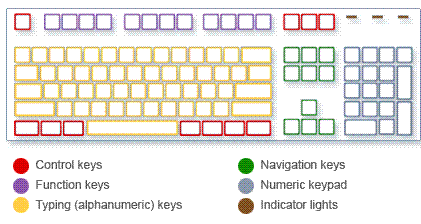Keyboards
Computer keyboads
A standard computer keyboard is like a typewriter keyboard with extras. For those with no experience of typewriters, the alphabet keys generate 'lower-case' (small) letters. Holding the 'shift' key down while typing a letter, turns the letters into 'upper-case' (CAPITALS). The 'Caps Lock key', above the left hand shift key, pressed once reverses the action of the shift key (for letters only). Pressed again, the action reverts to normal. Also use the shift key to turn the lower symbol on the key into the upper symbol on the key
A common mistake is to press the 'Caps Lock' key instead of the 'Shift Key'. There is no easy cure except to type your text again. While on the subject of capitals, you are often required to type in registration codes when installing software. Unless there is a mixture of upper and lower case characters, use the 'Caps Lock'.

The diagram above shows the different groups of keys. The yellow group belong to the keys that you will find on a typewriter. However, the yellow key at the right hand end called 'ent' or Enter/Return. corresponds to the large lever that sticks out at the right hand end of a typewriter.

The red, control, keys are used in combination with other keys to do various things. These combinations sre described in the following pages. Not all combinations will work on your computer, but you can find if they do by trying them. For example one on my keyboard, the '4' shows a third character, a euro symbol, '€'. Trying various combinations, showed that if I hold down the 'Ctrl' and 'Alt' keys with one hand and press the '4' key with the other I get an'€' symbol. This also works with the symbols key to the left of the '1' key.
The function keys,in purple, usually have a single use. For example, the 'F1' key usually opens a 'help' file. If you hold down the 'F8' key when you restart the computer it takes you to a screen where you can start in the 'Safe Mode'; useful after a computer crash.
The navigation keys, in green, are described in Word Processing.
